The big development this week is a sudden rise in concern over bird flu, or H5N1.
I say rise in concern rather than rise in risk.
Risk from H5N1 has been around for a long time. We have known for a while that human-to-human transmission, while it is not happening right now, could evolve at any time from not that many mutations.
What has changed in the past two weeks is that people are waking up to it. What has changed over the past year is that bird flu has spread throughout the wild bird population, has threatened our chicken population, and looks to have mammal-to-mammal transmission in a mink farm.
This is an overview of the situation.
Warnings of Danger
Zeynep Tufecki warns us of the danger (thread). It has already wrecked havoc on farms and caused egg prices to skyrocket. It threatens to become a pandemic in humans.
This pathogen, especially the H5N1 strain, hasn’t often infected humans, but when it has, 56 percent of those known to have contracted it have died. Its inability to spread easily, if at all, from one person to another has kept it from causing a pandemic.
But things are changing. The virus, which has long caused outbreaks among poultry, is infecting more and more migratory birds, allowing it to spread more widely, even to various mammals, raising the risk that a new variant could spread to and among people.
Alarmingly, it was recently reported that a mutant H5N1 strain was not only infecting minks at a fur farm in Spain but also most likely spreading among them, unprecedented among mammals. Even worse, the mink’s upper respiratory tract is exceptionally well suited to act as a conduit to humans, Thomas Peacock, a virologist who has studied avian influenza, told me.
The world needs to act now, before H5N1 has any chance of becoming a devastating pandemic.
We have many of the tools that are needed, including vaccines. What’s missing is a sense of urgency and immediate action.
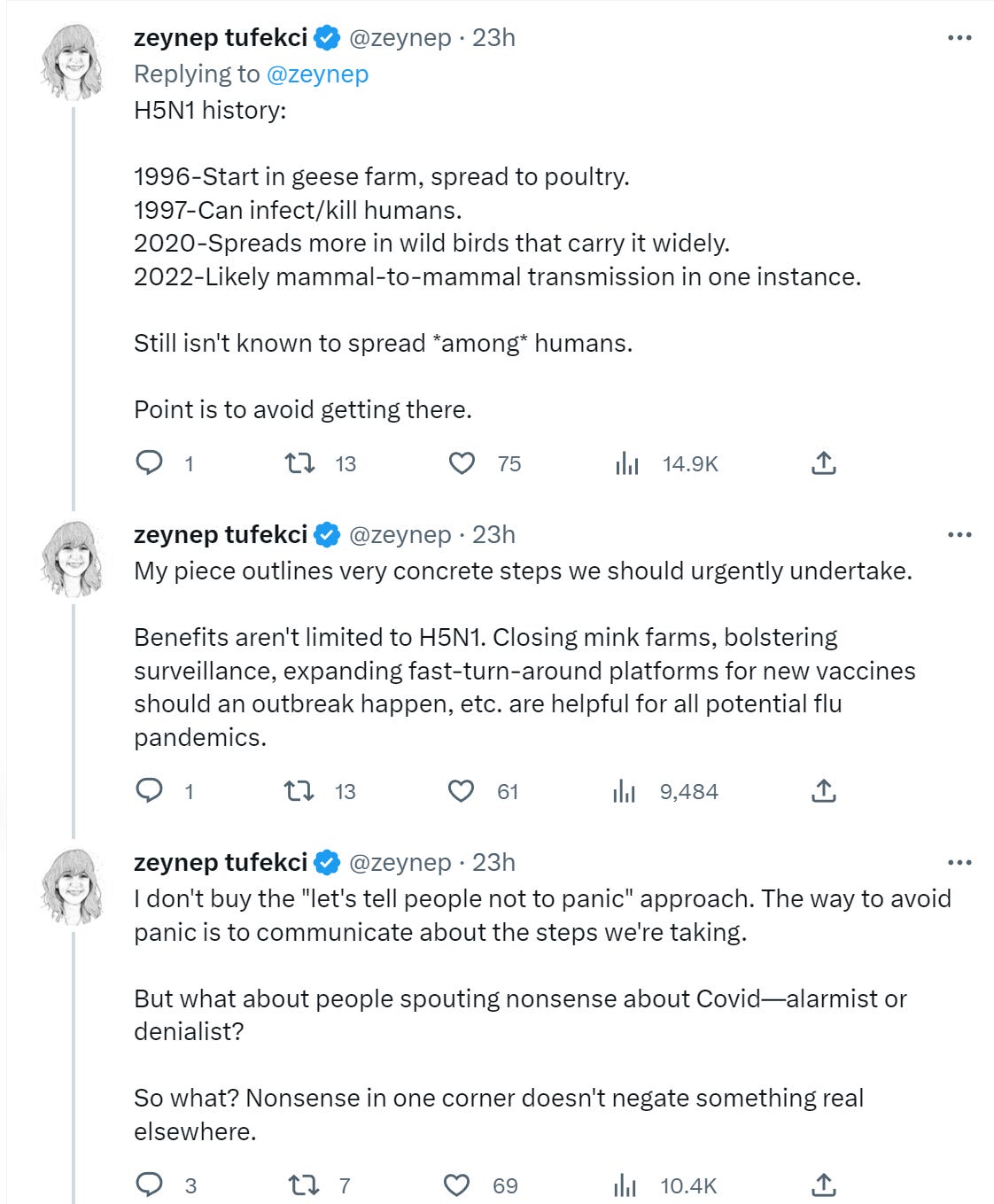
Obviously, we should not ‘panic’ and also should not consider the only choices to be ‘do nothing’ or ‘panic.’ Taking preventative action is not, and need not induce, panic.
The problem is that calls in such situations to Do Something or Do More usually end up with some combination of being ignored until it is too late, calls for Further Study, or various Sacrifices to the Gods. What can we actually do?
Here are her suggestions.
- Surveil pig farms for bird flu, pigs mostly don’t die from it but do spread it.
- Shut down mink farms.
- Make quick testing easily available, especially for farm workers.
- Don’t rely on a vaccine that needs to be incubated in chicken eggs to solve a pandemic that wipes out chickens.
- Don’t rely on producing a vaccine after the pandemic starts, which even in the best case scenario would take months. The non-chicken-egg vaccine would be so slow that after six months we would only have 150 million doses worldwide.
- To do this, prepare the necessary groundwork for the mRNA vaccines now, so they can be mass produced faster, in as little as three months.
- Allow voluntary vaccination now.
- Mass vaccinate poultry and pigs.
I would divide this into three categories, and I’d add a fourth she doesn’t mention.
- Better surveillance.
- Shut down mink farms.
- Taking vaccination seriously.
- Know what we will do if and when this does happen, and prepare to act.
You can overspend on surveillance in any situation, but here it seems hard. Easy one.
Shutting down mink factory farms seems overdetermined at this point if it can be done. They are an ideal incubation system for potential pandemics so we can mass produce a combination of fur and animal cruelty.
What I don’t want, however, is for the mink farms to be banned in America and Europe and then shift to third world countries. If we can’t effectively stop them, better to keep them where we can use reasonable safeguards and surveillance. My expectation is an American ban, which recently almost happened, would by default make the problems worse. So I’d be very careful before proceeding here.
Then there’s vaccines. Yes, of course, it is vastly overdetermined that we should have mRNA vaccines for H5N1 at the ready. At a minimum, approved and ready to start manufacturing at the drop of a hat. We should also absolutely make voluntary vaccinations available. Having farm workers who handle chickens able to get vaccinated now could help stop a pandemic. I am less sure about a mandate, even for narrow groups, but we should definitely allow it to whoever wants it.
Florian Krammer has a different list.


I do not know the pros and cons of vaccination of poultry. I do know that it is worth quite a lot to get this protection these days. My strong prior is that the ‘for several reasons’ above boils down to ‘the government does not allow it’ and so yes, if you were wondering why egg prices are so high, you can blame government rules against vaccination.
It does seem like a good idea to vaccinate those who handle poultry, either way.
Some people are using this moment to restart lockdown arguments.
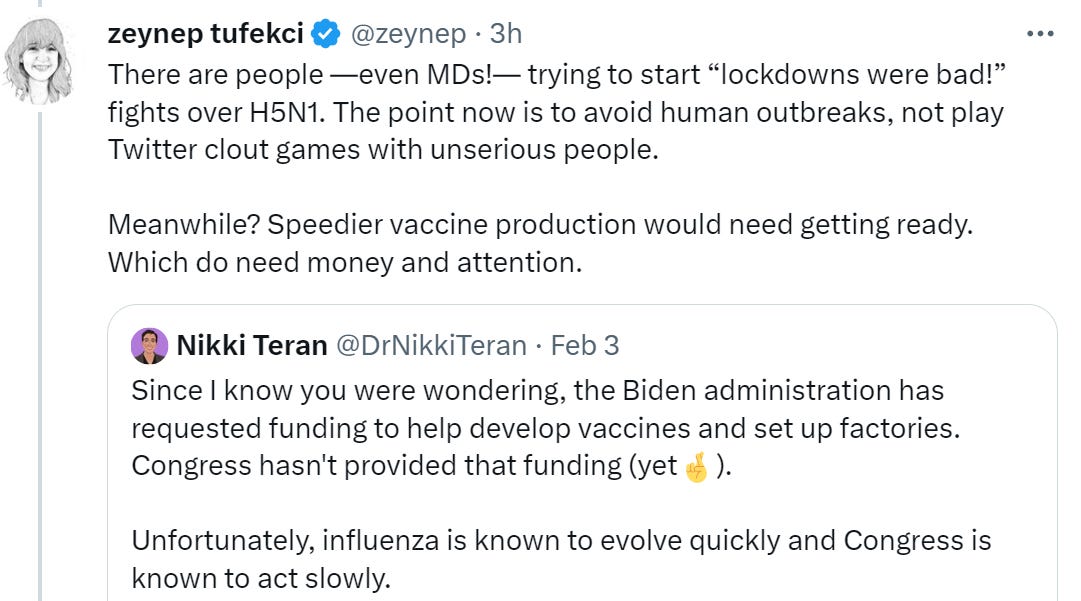
This confuses me, because if an H5N1 pandemic happens and people are dying orders of magnitude more often, then the procedures we should and would enact will make Covid lockdown procedures in China are going to look like a picnic.
The True Infection Fatality Rate (IFR) is Unknown
So far this thing kills half the people it infects, that we know about.
Will that hold?
Here is the Wikipedia post on human mortality from H5N1. True CFR seems very widely disputed…
Estimates of case-fatality (CF) rates for past influenza pandemics have ranged from to 2-3% for the 1918 pandemic to about 0.6% for the 1957 pandemic[1] to 0.2% for the 1968 pandemic. As of 2008, the official World Health Organization estimate for the case-fatality rate for the outbreak of H5N1 avian influenza was approximately 60%.[2] Public health officials in Ontario, Canada argue that the true case-fatality rate could be lower, pointing to studies suggesting it could be 0-1%, but warned that it was unlikely to be as low as the 0.1–0.4% rate that was built into many pandemic plans.
I assume ‘true’ case-fatality rate means infection fatality rate (IFR)?
Potentially H5N1 is roughly one hundred times deadlier than Covid. Also potentially it could be not that different from Covid, in which case it would be far deadlier for the young, especially the very young, while milder for the old.
A lot will depend on the exact strain. It seems some strains of H5N1 are extremely deadly to humans. Others are relatively mild. If a pandemic does happen, it could be anywhere on the spectrum from another Covid to orders of magnitude deadlier.
Certainly no one should be building a sub-1% death rate into their pandemic plans.
There is precedent that sometimes the flu can indeed have very high lethality: 1918.
The highly lethal second and third waves of the 1918 Spanish flu evolved through time into a less virulent and more transmissible human form. Although the overall fatality rate for the Spanish flu is estimated to have been 10% to 20% of the population, he lethal waves of the Spanish flu are not reported to have emerged with anything like the over-50% case fatality ratio observed to date in human H5N1 infection. Studies indicating that an H5N1 pandemic may be more pathogenic than was the Spanish flu include a mouse study in which the H5N1 virus elicited significantly higher levels of pro-inflammatory cytokines in the lungs.
Is there a chance we end up with a low only-modestly-higher-than-Covid fatality rate? Yes. It is possible. What do I expect is most likely? A number much higher than that, likely north of 10%, even 20% or more.
What Is Even Worse?
It is not entirely clear to me which one we should root for.
Obviously the best case (other than ‘this never happens at all’ which is definitely the top choice) is ‘this kills almost no one,’ or not enough people to justify a reaction, and public health officials howl while we essentially ignore it and go about our business the way we do with regular flu.
The worst case scenario is that suppression is impossible and also it is super deadly. But let us suppose that suppression is possible if we care enough – China has proven this was true for Covid, and H5N1 will likely be easier to contain than Covid. Note that being deadly helps a lot here.
In many ways, Covid was close to the worst-case scenario. We got a pandemic deadly enough that we suspended ordinary human interaction for years and caused massive disruptions. We took steps that were expensive, and had some impact, without having enough impact.
What we didn’t get was the kinds of actions that would have actually suppressed the virus.
I am absolutely not saying that those suppressive actions would have been a good idea. Quite the opposite. The right answer, knowing what we know now, would have been to do smarter things, and mostly do less prevention, at least once we were past the very early stages.
Given our previous experience with Covid, the ‘limbo zone’ is likely higher now than it was the first time. A lot of people will do some combination of not believing anything health officials say, and choosing life over avoiding death.
It would be a completely different scenario if instead of killing 0.5% of people infected at first, it killed 50%.
In that scenario, I do not know exactly how extreme I would go to isolate. I do know it would be rather f****** extreme if I thought that was what it took.
Bryan Caplan expresses here that he would mostly rather live his life and take the risk, however high. Even if you put in a 50% death rate, his math could go either way if he’s already elderly. If he’s young, however, and the death rate is still 50%? He’s isolating.
The absolutely right thing to do in the 50% scenario would be full suppression, no matter the economic costs of doing so. If that means effectively imposing martial law for several weeks to keep people at home, because nothing short of that would work? So be it. Consider the alternative.
I expect we would indeed do whatever it takes, which would then allow a return to relatively normal in most ways once the job was done.
The question is, how high is high enough that we could do this without a loss of civil order?
Everybody Vax Now
On a similar note, if there is a vaccine?

Yeah. Those people are wrong. Not that they are wrong to be upset at public health. They are wrong to think they will not take an H5N1 vaccine. They absolutely will take it, if there is a pandemic of H5N1, because they do not want to die. A death rate of 56%, or 25%, or even 10%, sharpens the mind in ways one of 0.2% does not.
WHO is being WHO and saying ‘needs to be monitored closely’ and ‘we must prepare’ without doing anything that might help prevent a pandemic from happening.
Will It Happen? How Unlikely Is It?
The risk of H5N1 jumping to human-to-human transmission in any given instance is low, but these risks add up over time.
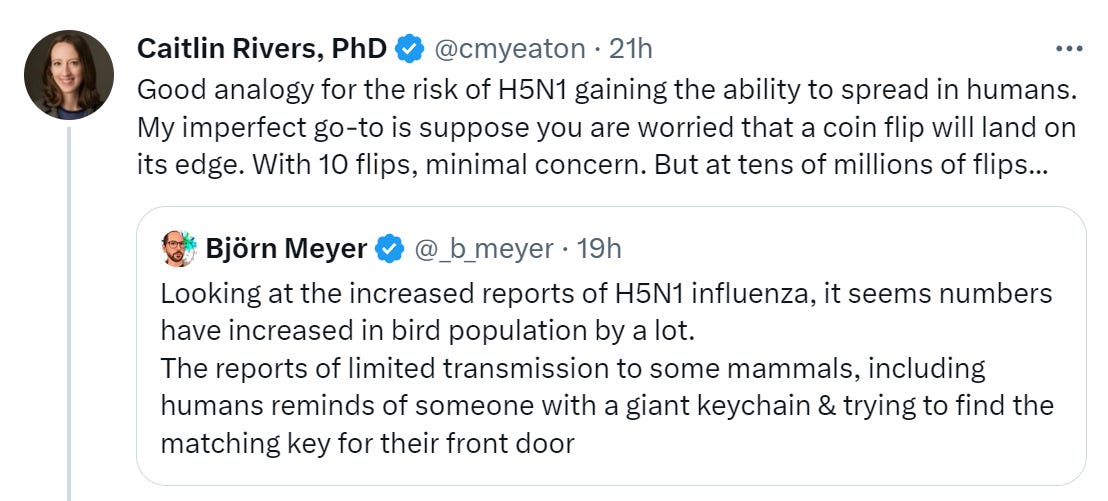

What would it take? This video (start at ~14:00) confirms what I have seen elsewhere, that there is a set of two mutations that together would likely allow human-to-human transmission. Two is a lot more than one, and a lot less than three. Might never happen, unlikely to happen soon, still seems like a time bomb.
What if anything should you do right now, on a personal level?
Do not touch sick or dead birds. If you find a dead wild bird, report it.
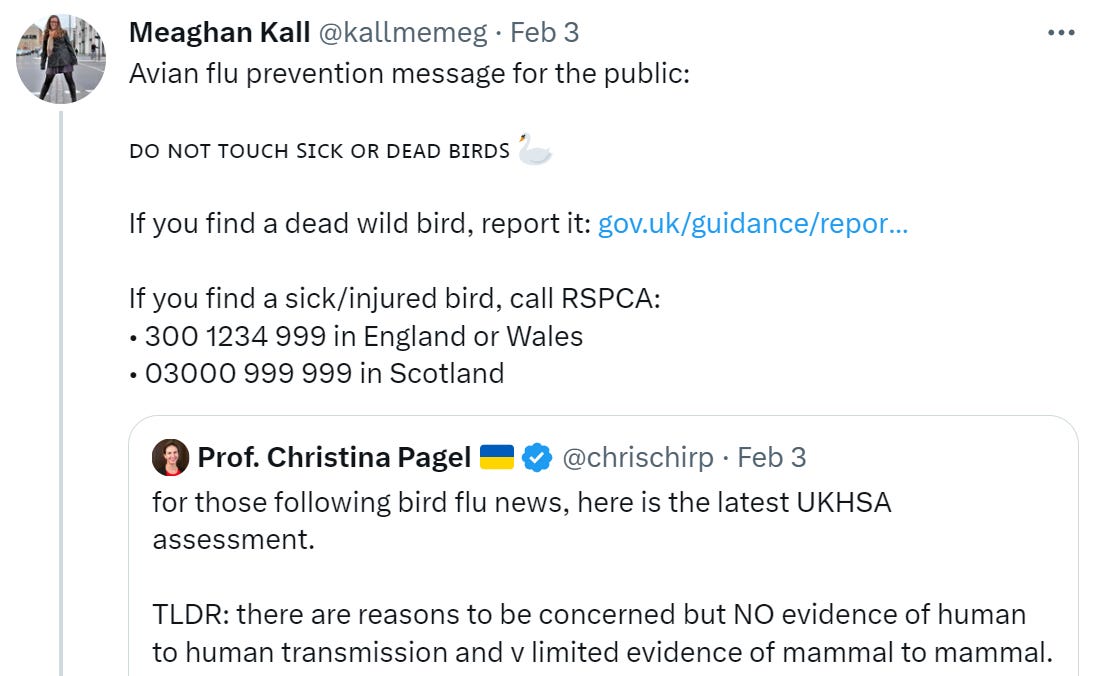
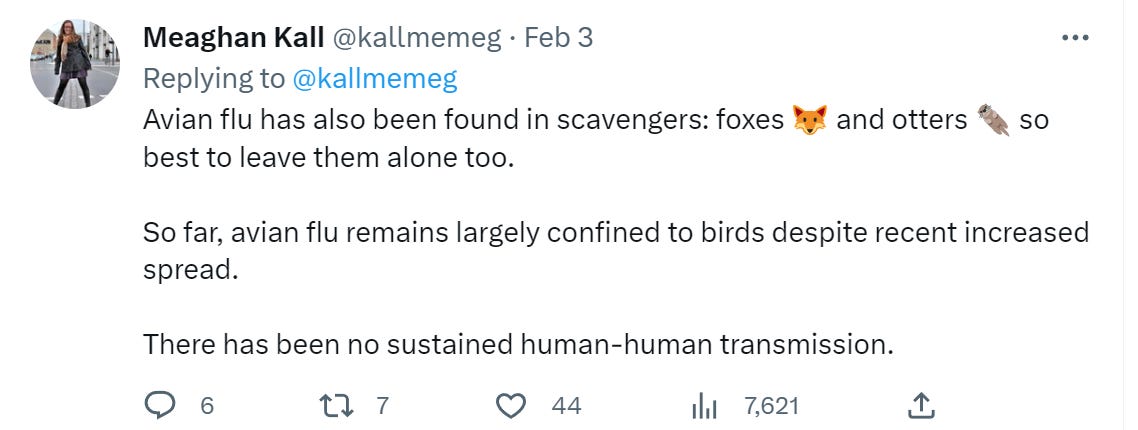
You could reasonably extend this to any physical interaction with wild birds.
Otherwise, it’s still far too early.


Keeping stocked up on masks and soap and such is good policy anyway, as is a flu shot, so sure, why not. There will also be plenty of warning, for anyone paying attention, to give you a window to do such things well before they get more expensive or difficult.
What you definitely don’t need to worry about is what you eat.
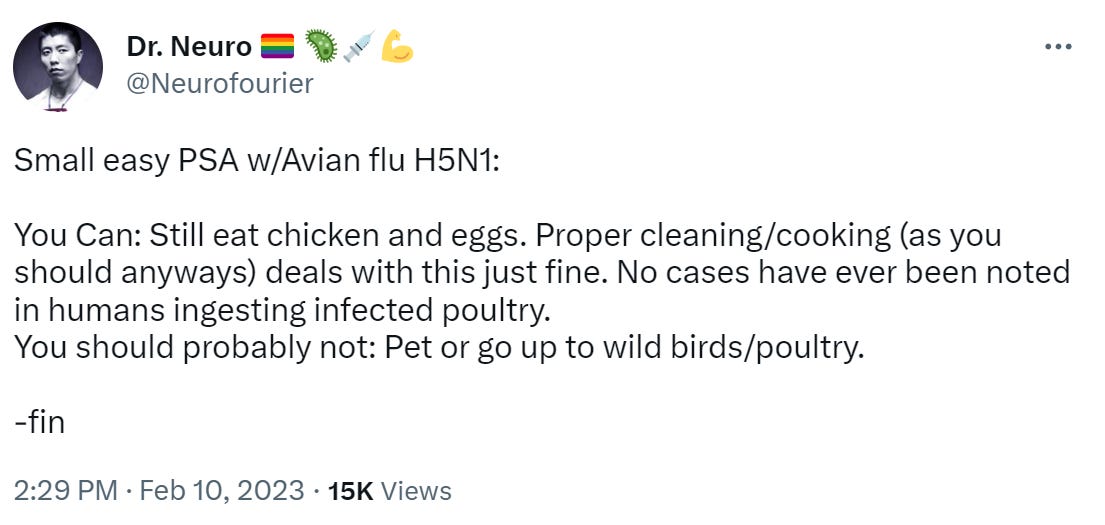
To the extent one needs to act now on an individual level, it would be things that had far longer lead times.
An Aside on Risk
Here is one relative skeptic that still agrees we should worry.


Whether or not you agree with the final estimate, this is important perspective.
We need, on many fronts, a lot more ‘single digit % chance is quite scary’ energy. For example, a lot of people seem willing to contribute to building AGI thinking it has a single digit percent chance of wiping out all value in the universe (usually phrased as ‘killing all the humans.’) A single digit risk of calamity is not fine – it can be worth the risk or unavoidable, but it is not fine. If you can do something about it, that is likely quite a good idea.
We need, on other fronts, a lot less ‘even a tiny chance is quite scary’ energy. Parents get arrested for letting children walk to Dunkin Donuts out of fear of ‘child molesters,’ after coming home from mandatory trauma in the form of school lockdown drills. Notice that these are a lot lower than single digit risks.
In the most extreme case, we have the famous ‘one percent doctrine’ of Dick Cheyney, who said ‘If there is a 1% chance that Pakistani scientists are helping al-Qaeda build or develop a nuclear weapon, we have to treat it as a certainty in terms of our response. It’s not about our analysis … It’s about our response.’
Needless to say, no, we should react very differently to 1% versus 100%.
So what do prediction markets say is the risk?
Manifold Markets is only sort of real money, it’s still the fastest game in town. Here’s an index of related markets. I do not love these odds.
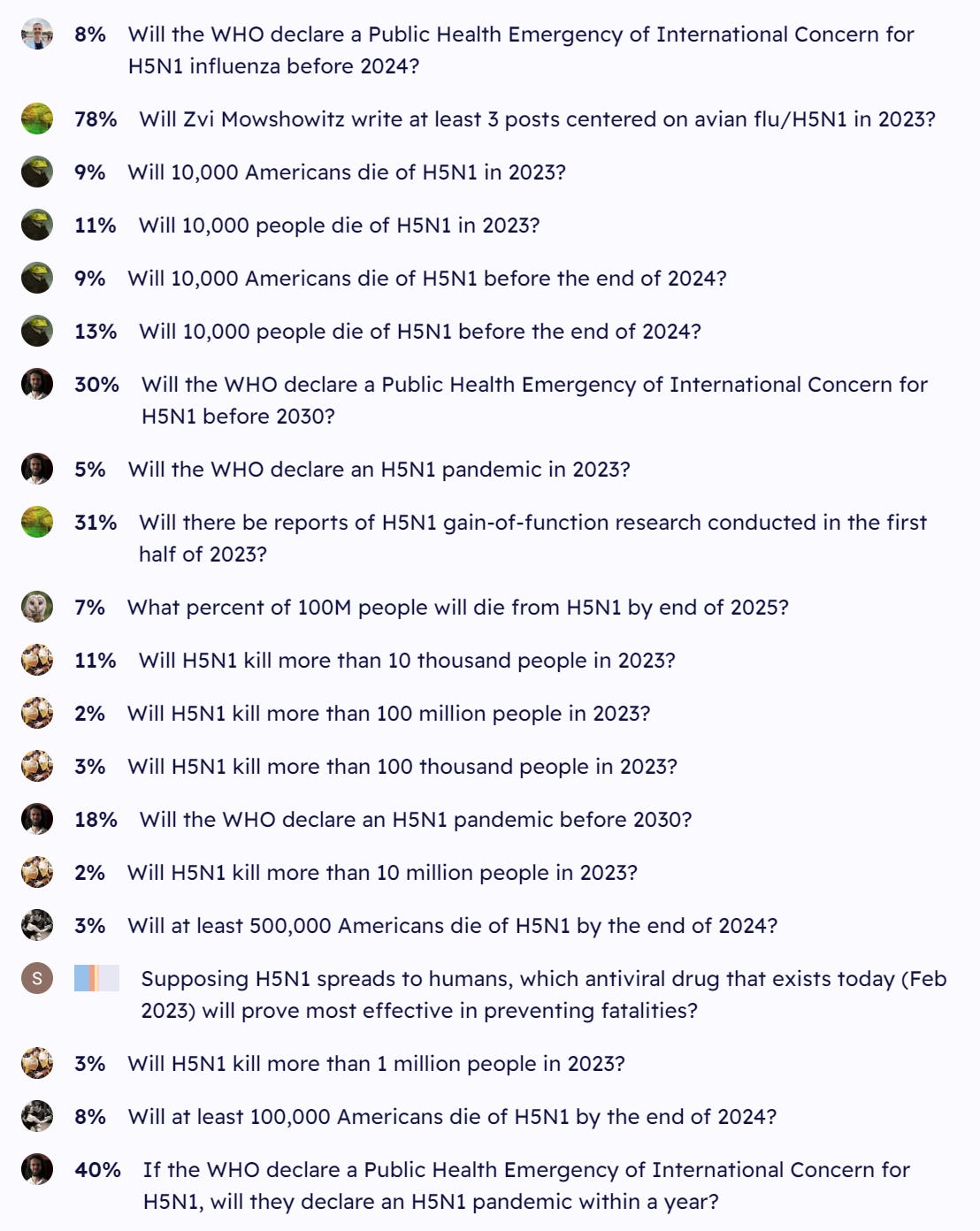
These odds have mostly been declining. This is normal for longshot markets. It is hard to trade something down to 10% or 5% let alone 2%, especially when no one is there ‘helping you along.’
After pasting that in, I sold the market on my own triple posting from 78% to 30%, despite being about to make post one. The way I see it, if I make a second post on H5N1, it means either human-to-human transmission or perhaps a huge economic crisis in the price of eggs and chicken. Neither seems all that likely. Otherwise, why would I need a second post? Certainly not a third one. Still, it’s generally never good practice to crash a market like this too much, in case others disagree with you, so you can get a better price and avoid huge mistakes.
The other good news to keep in mind is that prediction markets have a predictable longshot bias in these spots. If the market says 5%, your best estimate is substantially lower. Still, it is over 1%. I do not like those odds.

>Shutting down mink factory farms seems overdetermined at this point if it can be done. They are an ideal incubation system for potential pandemics so we can mass produce a combination of fur and animal cruelty.
I’m not seeing the distinction between banning mink factory farms and banning meat factory farms, or why either is “overdetermined”.
Shutting down mink factory farms lowers the supply of fur. Shutting down meat factory farms lowers the supply of meat. Meat is much more widely used, and people value it much more, than fur.
>Meat is much more widely used, and people value it much more, than fur.
Yes, obviously (I personally consume meat but not fur), but that’s why the factory farms for meat are much larger and more common than those for fur. It’s not obvious that the pandemic-externality of mink farms is greater, in proportion to the utility of their product, than the pandemic-externality of meat farms.
But the breadth and depth of demand makes the political economy totally different.
It seems useful to know whether there exists some technically feasible agricultural regulation that would substantially reduce pandemic risk from meat farming while still letting it go on at scale, perhaps with somewhat higher cost. This may be idle curiosity, though, since the political feasibility of “we are going to make chicken cost $1/lb more to reduce pandemic risk” may be ~just as hopeless as that of “we are going to ban chicken farming at scale altogether to reduce pandemic risk.”
@NW I think the case is not obvious for either of them, and am throwing a red flag because this looks a lot like it could fall into the “one-man-one-vote, so something only a small segment of society do gets banned because of insignificant security benefits to others” failure mode where banning mink is net-bad but gets done anyway.
Also, seemed kind of out-of-character for Zvi so I wanted to investigate whether there was something that I didn’t know about in play.
Pandemic externality is heavily dependant on how easily diseases can transfer from the given animal to humans; I don’t fully know the why of it, but it appears that minks specifically are considered a great risk for transmitting respiratory viruses, such that health orgs are much more concerned about a handful of minks having the flu than they are about millions of chickens getting it. (I also recall that it was considered big news when Covid infected a bunch of mink farms in Europe in 2020).
I would expect that pig farms are similarly risky, given their similarity to humans, but poultry, cattle and sheep are generally low risk for transmission.
“After pasting that in, I sold the market on my own triple posting from 78% to 30%, despite being about to make post one.”
I guess insider trading is partially the point of prediction markets? Still seems questionable.
Explicitly encouraged on Manifold – and if a particular market asked me not to, I wouldn’t do it.
“If that means effectively imposing martial law for several weeks to keep people at home, because nothing short of that would work? So be it.”
What’s the basis for assuming that imposing martial law for “several weeks” would work? If the idea is that because literally everyone will be isolated so that nobody can contract the disease and therefore it will be extinct after several weeks, then no, it should be obvious that’s not going to happen. So as soon as you lift martial law, you’ll have active infections among a fully interacting population just like before, and exponential growth will start right up again.
If martial law is imposed, it will last many months, not several weeks.
One would hope that if martial law is imposed, someone will receive advice from the armed forces on combined arms doctrine. That the isolation is trading
spacefor time, it is suppressing the spread, its whole purpose is to allow for a longer-lasting solution to be deliveredby the strike element.Yes, I know the Law of Continued Failure.
I agree with Schilling above that the duration of martial law would likely extend beyond a few weeks, hopefully not more than a few months.
I’m surprised to see so many prediction points concerning the WHO. Who cares about those guys? Do we remember nothing about their recent conduct?
I think prediction markets in more basic questions might be useful.
Will H5N1 show human transmissibility in a given time frame, say before 2030?
Will its IFR be in the same range, <3%, typical of past flu pandemics?
How long will it take to begin vaccinations after it is known to be spreading?
Will a vaccine be approved before a pandemic begins?
Will a vaccine be mass produced before a pandemic begins?
>I’m surprised to see so many prediction points concerning the WHO. Who cares about those guys? Do we remember nothing about their recent conduct?
Easy and uncontroversial to resolve whether the WHO has declared PHEIC/pandemic or has not. Prediction markets like resolvable questions – presumably, this affects Manifold to some extent even though it’s not as strictly-required as for Lawful Good markets.
The WHO is substantially corrupted by realpolitik issues (particularly with the CPC), but it’s still an organisation that has a formal “is this a pandemic y/n” process as part of its mandate. I don’t know off the top of my head if even the US CDC formally classifies things as being pandemics or not.
“Bolstering surveillance” she’s lost me.
Naive question: why can’t the annual flu shot this year include vaccination against H5N1 just in case?
My probably incomplete/inaccurate mental model of annual flu shots is that each year in the spring/summer sometime, Experts ™ pick several strains to include based on how much badness they predict they can prevent by including those strains vs other strains that could be targeted by this year’s shot. And then somehow enough gets manufactured that everyone who wants a flu shot that fall can get one.
Is bird flu vaccine sufficiently harder to manufacture than the “regular” kind that it would not be technically feasible to add it as one of this year’s strains? Or is the barrier that putting a strain in the annual shot that hasn’t yet jumped to humans is Just Not Done, that protecting against those kinds of downside risks isn’t part of the institutional mission? Or is there some other issue?
Okay, finally got around to reading this.
The reason chickens aren’t vaccinated is that that the usual tests for infection can’t tell the difference between infected chickens and vaccinated chickens, so if you vaccinate your chickens you have a lot of trouble trying to export them.
Also, making an H5N1 vaccine now has the usual problem with influenza vaccines: flu viruses mutate a lot in ways that let them avoid the immune reactions to older strains, so you need to keep updating the vaccines to be effective against the current version. We don’t actually have the version of the virus yet that we need to worry about, so any vaccine we make today might not be particularly effective against tomorrow’s pandemic flu.